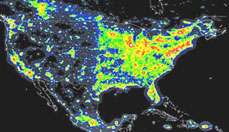This Saturday, March 29, millions of people around the world will turn OFF the lights from 8-9PM (your local time) for Earth Hour.
Some of the world’s most iconic skylines, including Atlanta, Chicago, Phoenix and San Francisco, will go dark for one hour in this dramatic call for action on climate change.
With 25 cities participating in 10 countries, Earth Hour will be the largest voluntary power down in history. This year partner cities include: Adelaide, Bangkok, Brisbane, Canberra, Christchurch, Copenhagen, Dublin, Manila, Melbourne, Montreal, Odense, Ottawa, Perth, Suva, Sydney, Tel Aviv, Toronto, and Vancouver. In the US, Denver, Miami and Charlotte have also signed on.
Last year, 2.2 million people and 2,100 Sydney, Australia businesses turned off their lights for one hour. The collective effort reduced energy consumption by 10.2% for one hour, the equivalent effect of taking 48,000 cars off the road for a year.
North American cities such as Chicago, Toronto, Minneapolis/St. Paul, and Detroit have initiated ongoing Lights-Out programs to reduce greenhouse emissions, save money, and protect migrating birds.
The bulk of spring migration dates from mid-March through June, while fall migration begins in mid-August, and extends through October. Many migratory birds fly at night, and when they are killed by collisions with large buildings and other structures, it is because of light.
Birds evolved over millions of years to navigate their migration routes in dark skies, greatly aided by the light of the stars and moon to orient themselves on these flights. Starlight is made vastly less visible by the light pollution from our towns and cities, and thus interferes with the birds’ ability to reach their destinations safely.
Unfortunately, the artificial lights of our cities and towns present a serious hazard to migratory birds, particularly during times of low cloud cover and inclement weather. The birds seem to become disoriented by these lights, become attracted to lit structures, and often collide with them and each other, leading to their injury and death. The U.S. Fish and Wildlife Service estimates that as many as 900 million birds are killed in collisions each year.

